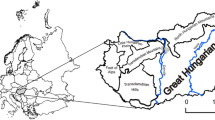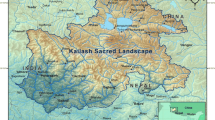Abstract
The assessment of regional climate change impacts combined with the sensitivity of landscape functions by predictive modelling of hazardous landscape processes is a new fundamental field of research. In particular, this study investigates the effects of changing weather extremes on meso-regional-scale landscape vulnerability. Climatic-exposure parameter analysis was performed on a predicted climate change scenario. The exposure to climate change was analysed on the basis of the original data of the meso-scale IPCC A1B climate scenario from the REMO and ALADIN regional models for the periods of 2021–2050 and 2071–2100, and the regional types of climate change impacts were calculated by using cluster analysis. Selected climate exposure parameters of the REMO and ALADIN models were analysed, in particular, for extreme events (days with precipitation greater than 30 mm, heat waves, dry periods, wet periods) and for daily temperature and precipitation. The landscape functions impacted by climate change are proxies for the main recent and future problematic processes in Hungary. Soil erosion caused by water, drought, soil erosion caused by wind, mass movement and flash floods were analysed for the time periods of 1961–1990, 2021–2050 and 2071–2100. Based on the sensitivity thresholds for the impact assessments, the landscape functional sensitivity indicators were interpreted, and an integrative summary of the five indicators was made, differentiating the regions facing only a few or multiple sensitivities. In Central Hungary, the increasing exposure and sensitivity to droughts will be a serious problem when following the REMO scenario. In several regions, most indicators will change the sensitivity threshold from a tolerable risk to an increased or very high risk.




Similar content being viewed by others
References
Agrotopographical Database (1991) Budapest, http://www.mta-taki.hu/en/departments/gis-lab/agrotopo_en
Bartholy J, Pongrácz R (2010) Analysis of precipitation conditions for the Carpathian Basin based on extreme indices in the 20th century and climate simulations for the 21st century. Phys Chem Earth 35:43–51
Bartholy J, Pongrácz R, Barcza Z, Haszpra L, Gelybó G, Kern A, Hidy D, Torma C, Hunyady A, Kardos P (2007) The regional consequences of the climate change: present status and expected trends. Földrajzi Közlemények 55:257–269 (In Hungarian)
Bartholy J, Pongrácz R, Gelybó G, Szabó P (2008) Analysis of expected climate change in the Carpathian Basin using the PRUDENCE results. Időjárás 112:249–264 (In Hungarian)
Carpenter TM, Sperfslage JA, Georgakakos KP, Sweeney T, Fread DL (1999) National threshold runoff estimation utilizing GIS is support of operational flash flood warning systems. J Hydrol 224:21–44
Csima G, Horányi A (2008) Validation of the ALADIN—Climate regional climate model at the Hungarian Meteorological Service. Időjárás 112(3–4):155–177
Czigány S, Pirkhoffer E, Balassa B, Bugya T, Bötkös T, Gyenizse P, Nagyváradi L, Lóczy D, Geresdi I (2010) Flash floods as a natural hazard in Southern Transdanubia. Földrajzi Közlemények 134:281–298 (In Hungarian)
Estrela T, Menéndez M, Dimas M, Marcuello C, Rees G, Cole G, Weber K, Grath J, Leonard J, Ovesen NB, Fehér J (2001) EEA Sustainable water use in Europe. Part 3: Extreme hydrological events: floods and droughts. http://www.eea.europa.eu/publications/Environmental_Issues_No_21
European Environment Agency (2000) CORINE land cover technical guide—Addendum 2000. EEA, Copenhagen
Faragó T, Láng I, Csete L (eds) (2010) Climate change and Hungary: mitigating the hazard and preparing for the impacts (The “VAHAVA” Report). http://www.unisdr.org/files/18582_thevahavareport08dec2010.pdf
Fodor T, Kleb B (1986) Engineering geological overview of Hungary. MÁFI, Budapest, p 199
Grundfest E, Rips A (2000) Flash floods. In: Parker DJ (ed) Floods 2002, vol 1. Routledge, London, pp 377–390
IPCC 2007 Climate Change 2007: The physical science basis. Working group I contribution to the fourth assessment report of the IPCC. In: Solomon S, Qin D, Manning M, Chen Z, Marquis M, Averyt KB, Tignor M, Miller HL (eds) Cambridge University Press, New York, http://www.ipcc.ch
Jentsch A, Beierkuhnlein C (2008) Research frontiers in climate change: effects of extreme meteorological events on ecosystems. CR Geosci 340:621–628
Juhász Á (2004) Mass movement endangering human settlements and structures along the high bluff flanking Lake Balaton. Földrajzi Közlemények 52:19–30 (in Hungarian)
Kertész Á, Centeri C (2006) Hungary. In: Poesen J, Boardman J (eds) Soil erosion in Europe. Wiley, London, pp 139–153
Klik A (2004) Wind erosion assessment in Austria using wind erosion equation and GIS. In: OECD: Agricultural impacts on soil erosion and soil biodiversity: developing indicators for policy analysis, Paris, www.oecd.org/tad/env/indicators
Loibl W, Aubrecht Ch (2011) Hungary Climate Regions: Regional statistical analysis of selected Climate Change related indicators and classification of physiogeographic Meso-Regions to Climate Change region types. AIT – Austrian Institute of Technology Vienna, p 52
Lóki J (2011) Research of the land forming activity of wind and protection against wind erosion in Hungary. Riscuri Si Catastrofe 10:1–13 http://riscurisicatastrofe.reviste.ubbcluj.ro/Volume/X_Nr_9_2011/PDF/J%20Loki.pdf
Martens P, Aerts JCJH, Amelung SB, Bouwer LM, Huynen M, Chang CT, Ierland EC, Koppen CSA, McEvoy D, Mol APJ, Tatenhove JPM (2010) Imagining the unimaginable: synthesis of essays on abrupt and extreme climate change. Curr Opin Environ Sustain 2:347–355
Metzger M, Schröter D, Leemans R, Cramer W (2008) A spatially explicit and quantitative vulnerability assessment of ecosystem service change in Europe. Reg Environ Change 8:91–107
Meyer BC, Rannow S, Greiving S, Gruehn D (2009) Regionalisation of climate change impacts in Germany for the usage in spatial planning. GeoScape 1:34–43
Meyer BC, Rannow S, Loibl W (2010) Climate change and spatial planning. Landsc Urban Plan 98:139–140
Mücher CA, Klijn JA, Wascher DM, Schaminée JHJ (2010) A new European landscape classification (LANMAP): a transparent, flexible and user-oriented methodology to distinguish landscapes. Ecol Ind 10:87–103
Opdam P, Washer D (2004) Climate change meets habitat fragmentation: linking landscape and biogeographical scale levels in research and conservation. Biol Conserv 117:285–297
Pálfai I (2004) Undrained runoff and droughts in Hungary (Hydrologic Studies). KözDoc, Budapest p 492
Pécsi M, Somogyi S (1967) Magyarország természeti földrajzi tájai és geomorfológiai körzetei. Földrajzi. Közlemények 15:285–304
Pieczka I, Pongrác R, Bartholy J, Kis A, Miklós E (2011) Estimated extreme climatical data in the Region of Carpathian-basin using results of the ENSEMBLES project. OMSZ, Budapest, pp 76–85 (in Hungarian)
Pielke RA Sr, Adegoke JO, Chase TN, Marshall CH, Matsui T, Niyogi D (2007) A new paradigm for assessing the role of agriculture in the climate system and in climate change. Agric For Meteorol 142:234–254
Pongrácz R, Bartholy J, Szabó P, Gelybó G (2009) Comparison of observed trends and simulated changes in extreme climate indices in the Carpathian basin by the end of this century. Int J Global Warm 1:336–355
Rakonczai J (2011) Effects and consequences of global climate change in the Carpathian Basin. In: Blanco J, Kheradmand H (eds) Climate change—geophysical foundations and ecological effects, pp 297–322
Rannow S, Loibl W, Greiving S, Gruehn D, Meyer BC (2010) Potential impacts of climate change in Germany—identifying regional priorities for adaptation activities in spatial planning. Landsc Urban Plan 98:160–171
Stefanovits P (1981) Pedology. Mezőgazdasági Kiadó, Budapest, p 376 (In Hungarian)
Szabó J, Lóki J, Tóth C, Szabó G (2008) Natural hazards in Hungary. In: Kertész Á, Kovács Z (eds) Dimensions and trends in Hungarian geography. MTA FKI, Budapest, pp 55–68
Szabó P, Horányi A, Krüzselyi I, Szépszó G (2011) The climate modelling at Hungarian Meteorological Survey: ALADIN and REMO. OMSZ, Budapest, pp 87–101 (In Hungarian)
Szépszó G (2008) Regional change of extreme characteristics over Hungary based on different regional climate models of the PRUDENCE project. Időjárás 112(3–4):265–284
Szépszó G, Horányi A (2008) Transient simulation of the REMO regional climate model and its evaluation over Hungary. Időjárás 112(3–4):203–231
Tobin GA, Montz BE (1997) Natural hazards: explanation and integration. Guilford Publishing, New York, p 388
Usher M (2001) Landscape sensitivity: from theory to practice. Catena 42:375–383
Van Leeuwen B, Tobak Z, Szatmári J (2008) Development of an integrated ANN—GIS framework for inland excess water monitoring. J Environ Geogr 1:1–6
Wischmeier WH, Smith DD (1978) Predicting rainfall erosion losses: a guide to conservation planning. Agriculture Handbook No. 537. USDA/Science and Education Administration, US. Govt. Printing Office, Washington, p 58
Wisner B, Blaikie P, Cannon T, Davis I (1994) At risk: natural hazards. People’s vulnerability and disasters. Routledge, New York, p 447
Acknowledgments
This publication is part of a research project “Creating the Centre of Excellence at the University of Szeged”, which is funded and supported by the European Union and co-financed by the European Regional Development Fund (TÁMOP-4.2.1/B-09/1/KONV-2010).
Author information
Authors and Affiliations
Corresponding author
Rights and permissions
About this article
Cite this article
Mezösi, G., Meyer, B.C., Loibl, W. et al. Assessment of regional climate change impacts on Hungarian landscapes. Reg Environ Change 13, 797–811 (2013). https://doi.org/10.1007/s10113-012-0326-1
Received:
Accepted:
Published:
Issue Date:
DOI: https://doi.org/10.1007/s10113-012-0326-1




